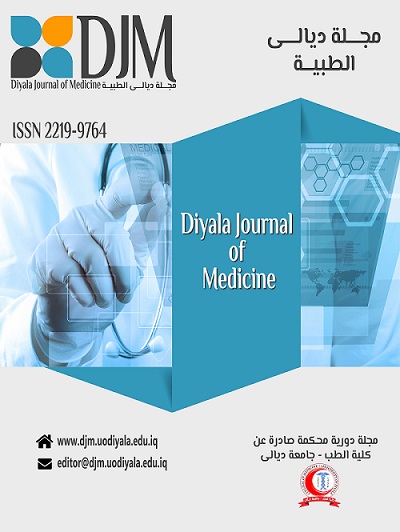Abstract
Background: Parkinson’s disease may be caused by oxidative stress within cells
due to defective nucleoli. Dopamine producing neurons are particularly sensitive to
oxidative stress. The researcher's present evidence showing defective nucleoli within
dopamine producing neurons lead to oxidative stress and damage
Objective: To assess antioxidant activity in Parkinson patients with autonomic
dysfunction.
Materials and Methods: samples were collected in Al Kadhimiya Teaching
hospital and Baquba teaching hospital in a period lasts from 1st January to 1st
November 2013. Antioxidant activity had been tested in 44 Parkinson patients with
autonomic dysfunction, 23 Parkinson patients without autonomic dysfunction and 25
healthy matched controls; using (Antioxidant Capacity, Total BioAssay™ Kit ;US
Biological company, Catalog No. A2298-43).
Results: antioxidant activity showed a reduction in its level in Parkinson patients
without autonomic dysfunction (0.75) with further reduction in Parkinson patient
with autonomic dysfunction (0.37) compared with the control groups (1.2).
Conclusion: Oxidative stress and antioxidants have a role in pathogenesis of
Parkinson disease. Both increase oxidative stress (direct) and a reduction in activity
of the antioxidants (indirectly) cause loss of neuron and reinforcing damage
mechanisms that play a role in autonomic dysfunction in Parkinson Disease.
due to defective nucleoli. Dopamine producing neurons are particularly sensitive to
oxidative stress. The researcher's present evidence showing defective nucleoli within
dopamine producing neurons lead to oxidative stress and damage
Objective: To assess antioxidant activity in Parkinson patients with autonomic
dysfunction.
Materials and Methods: samples were collected in Al Kadhimiya Teaching
hospital and Baquba teaching hospital in a period lasts from 1st January to 1st
November 2013. Antioxidant activity had been tested in 44 Parkinson patients with
autonomic dysfunction, 23 Parkinson patients without autonomic dysfunction and 25
healthy matched controls; using (Antioxidant Capacity, Total BioAssay™ Kit ;US
Biological company, Catalog No. A2298-43).
Results: antioxidant activity showed a reduction in its level in Parkinson patients
without autonomic dysfunction (0.75) with further reduction in Parkinson patient
with autonomic dysfunction (0.37) compared with the control groups (1.2).
Conclusion: Oxidative stress and antioxidants have a role in pathogenesis of
Parkinson disease. Both increase oxidative stress (direct) and a reduction in activity
of the antioxidants (indirectly) cause loss of neuron and reinforcing damage
mechanisms that play a role in autonomic dysfunction in Parkinson Disease.
Keywords
Parkinson's disease; autonomic dysfunct
Abstract
الخلفية: قد يكون مرض باركنسون ناتجا عن الإجهاد التأكسدي داخل الخلايا
بسبب النواة المعيبة. الخلايا العصبية المنتجة للدوبامين حساسة بشكل خاص ل
الإجهاد التأكسدي. الأدلة الحالية للباحث تظهر النواة المعيبة داخل
تؤدي الخلايا العصبية المنتجة للدوبامين إلى الإجهاد التأكسدي والأضرار
الهدف: تقييم نشاط مضادات الأكسدة في مرضى باركنسون الذين يعانون من اللاإرادية
خلل وظيفي.
المواد والأساليب: تم جمع العينات في تعليم الكاذمية
المستشفى ومستشفى باقوبا التعليمي في فترة تستمر من 1 يناير إلى 1 يناير
نوفمبر 2013. تم اختبار نشاط مضادات الأكسدة في 44 مريضا بمرض باركنسون يعانون من
الخلل اللاإرادي، 23 مريضا باركنسون بدون خلل وظيفي لاإرادي و25
عناصر التحكم المتطابقة الصحية؛ باستخدام (قدرة مضادات الأكسدة، مجموعة BioAssay ™؛ الولايات المتحدة
الشركة البيولوجية، رقم الكتالوج. رقم A2298-43).
النتائج: أظهر نشاط مضادات الأكسدة انخفاضا في مستواه في مرضى باركنسون
بدون خلل وظيفي لاإرادي (0.75) مع مزيد من الانخفاض في مريض باركنسون
مع خلل وظيفي لاإرادي (0.37) مقارنة بالمجموعات الضابطة (1.2).
الخلاصة: الإجهاد التأكسدي ومضادات الأكسدة لها دور في التسبب في
مرض باركنسون. كلاهما يزيد من الإجهاد التأكسدي (مباشر) ويقلل من النشاط
من مضادات الأكسدة (بشكل غير مباشر) تسبب فقدان الخلايا العصبية وتعزيز الضرر
الآليات التي تلعب دورا في الخلل اللاإرادي في مرض باركنسون.
بسبب النواة المعيبة. الخلايا العصبية المنتجة للدوبامين حساسة بشكل خاص ل
الإجهاد التأكسدي. الأدلة الحالية للباحث تظهر النواة المعيبة داخل
تؤدي الخلايا العصبية المنتجة للدوبامين إلى الإجهاد التأكسدي والأضرار
الهدف: تقييم نشاط مضادات الأكسدة في مرضى باركنسون الذين يعانون من اللاإرادية
خلل وظيفي.
المواد والأساليب: تم جمع العينات في تعليم الكاذمية
المستشفى ومستشفى باقوبا التعليمي في فترة تستمر من 1 يناير إلى 1 يناير
نوفمبر 2013. تم اختبار نشاط مضادات الأكسدة في 44 مريضا بمرض باركنسون يعانون من
الخلل اللاإرادي، 23 مريضا باركنسون بدون خلل وظيفي لاإرادي و25
عناصر التحكم المتطابقة الصحية؛ باستخدام (قدرة مضادات الأكسدة، مجموعة BioAssay ™؛ الولايات المتحدة
الشركة البيولوجية، رقم الكتالوج. رقم A2298-43).
النتائج: أظهر نشاط مضادات الأكسدة انخفاضا في مستواه في مرضى باركنسون
بدون خلل وظيفي لاإرادي (0.75) مع مزيد من الانخفاض في مريض باركنسون
مع خلل وظيفي لاإرادي (0.37) مقارنة بالمجموعات الضابطة (1.2).
الخلاصة: الإجهاد التأكسدي ومضادات الأكسدة لها دور في التسبب في
مرض باركنسون. كلاهما يزيد من الإجهاد التأكسدي (مباشر) ويقلل من النشاط
من مضادات الأكسدة (بشكل غير مباشر) تسبب فقدان الخلايا العصبية وتعزيز الضرر
الآليات التي تلعب دورا في الخلل اللاإرادي في مرض باركنسون.
Keywords
مرض باركنسون؛ ضعف اللاإرادي، نشاط مضاد للأكسد
